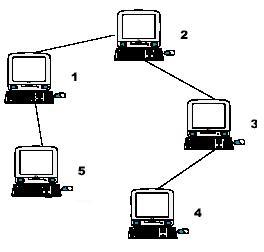Computer
Time Limit: 1000/1000 MS (Java/Others) Memory Limit: 32768/32768 K (Java/Others)Total Submission(s): 4715 Accepted Submission(s): 2376
Problem Description
A school bought the first computer some time ago(so this computer's id is 1). During the recent years the school bought N-1 new computers. Each new computer was connected to one of settled earlier. Managers of school are anxious about slow functioning of the net and want to know the maximum distance Si for which i-th computer needs to send signal (i.e. length of cable to the most distant computer). You need to provide this information.

Hint: the example input is corresponding to this graph. And from the graph, you can see that the computer 4 is farthest one from 1, so S1 = 3. Computer 4 and 5 are the farthest ones from 2, so S2 = 2. Computer 5 is the farthest one from 3, so S3 = 3. we also get S4 = 4, S5 = 4.

Hint: the example input is corresponding to this graph. And from the graph, you can see that the computer 4 is farthest one from 1, so S1 = 3. Computer 4 and 5 are the farthest ones from 2, so S2 = 2. Computer 5 is the farthest one from 3, so S3 = 3. we also get S4 = 4, S5 = 4.
Input
Input file contains multiple test cases.In each case there is natural number N (N<=10000) in the first line, followed by (N-1) lines with descriptions of computers. i-th line contains two natural numbers - number of computer, to which i-th computer is connected and length of cable used for connection. Total length of cable does not exceed 10^9. Numbers in lines of input are separated by a space.
Output
For each case output N lines. i-th line must contain number Si for i-th computer (1<=i<=N).
Sample Input
5 1 1 2 1 3 1 1 1
Sample Output
3 2 3 4 4题意: 给一棵树,每条树边都有权值,问从每个顶点出发,经过的路径权值之和最大为多少?每条树边都只能走一次。分析:以每个结点为根找到最长的子节点链,加上该结点为孩子的另一支子树链。详细解析#include <iostream> #include <cstdio> #include <cstring> #include <stack> #include <queue> #include <map> #include <set> #include <vector> #include <cmath> #include <algorithm> using namespace std; const double eps = 1e-6; const double pi = acos(-1.0); const int INF = 0x3f3f3f3f; const int MOD = 1000000007; #define ll long long #define CL(a,b) memset(a,b,sizeof(a)) #define MAXN 10005 struct node { int v,len,sum; node *next; }tree[MAXN*2], *head[MAXN*2]; int n,ptr,vis[MAXN]; int dp[MAXN]; void init() { ptr=1; CL(vis, 0); CL(dp, 0); CL(head, NULL); } void add(int s, int e, int len)//建树 { tree[ptr].v = e; tree[ptr].len = len; tree[ptr].next = head[s];head[s] = &tree[ptr++]; tree[ptr].v = s; tree[ptr].len = len; tree[ptr].next = head[e],head[e] = &tree[ptr++]; } void dfs1(int idx)//以idx为根的最长链 { vis[idx] = 1; node *p = head[idx]; while(p != NULL) { if(!vis[p->v]) { dfs1(p->v); dp[idx] = max(dp[idx], dp[p->v]+p->len); p->sum = dp[p->v]+p->len; } p = p->next; } } void dfs2(int father, int child)//同根的另一支子树 { if(vis[child]) return ; vis[child] = 1; int maxx = 0; node *p = head[father]; while(p != NULL)//找到父节点除child外其他分支的最大价值 { if(p->v != child) maxx = max(maxx, p->sum); p = p->next; } p = head[child]; while(p !=NULL)//继续往上更新,才能保证每步都得到最优解 { if(p->v == father) { p->sum = p->len + maxx; break; } p = p->next; } p = head[child]; while(p != NULL)//每次都更新当前节点,并往下递归计算,父节点会因为vis=1而不计算 { dp[child] = max(dp[child], p->sum); dfs2(child, p->v); p = p->next; } } int main() { int a,b; while(scanf("%d",&n)==1) { init(); for(int i=2; i<=n; i++) { scanf("%d%d",&a,&b); add(i, a, b); } dfs1(1); CL(vis, 0); node *p = head[1]; while(p != NULL) { dfs2(1, p->v); p = p->next; } for(int i=1; i<=n; i++) printf("%d\n",dp[i]); } return 0; }
























 504
504

 被折叠的 条评论
为什么被折叠?
被折叠的 条评论
为什么被折叠?








